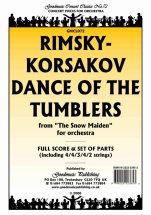Dance of the Tumblers -from The Snow Maiden
Buy this item (in stock)
Product ID: GM1 CL072
By Nikolai Rimsky Korsakov
Publisher:
Goodmusic
Series:
Concert Classics
Genre:
Romantic Era
Line Up:
Symphony Orchestra
Duration:
3:30
Level: 3
Set & Score
This item is in stock
About this item
Sometimes also known as the Dance of the Buffoons, or Dance of the Clowns (it depends how you translate it!), this exciting work is taken from Rimsky-Korsakov's opera "The Snow Maiden" which was written between 1877 and 1882. This edition is presented in the original scoring and has not been arranged or simplified.
Instrumentation
Piccolo, 2 Flutes, 2 Oboes, 2 Clarinets in Bb, 2 Bassoons 4 Horns in F, 2 Trumpets in Bb, 3 Trombones, Tuba, Timpani, Percussion (Triangle, Tambourine, Cymbals, Bass drum) Strings (Violin 1, Violin 2, Viola, Cello, Bass)
Reviews and rating
No review available, be the first to write one!

Composer
Nikolai Rimsky Korsakov (1844-1908)
Nikolai Andreyevich Rimsky-Korsakov (Russian: Никола́й Андре́евич Ри́мский-Ко́рсаков, Nikolaj Andreevič Rimskij-Korsakov, Russian pronunciation: [nʲɪkəˌlaj ˌrʲim.skʲɪj ˈkorsəkəf], 18 March [O.S. 6 March] 1844,[a 1] – 21 June [O.S. 8 June] 1908) was a Russian composer, and a member of the group of composers known as The Five.[a 2] He was a master of orchestration. His best-known orchestral compositions—Capriccio Espagnol, the Russian Easter Festival Overture, and the symphonic suite Scheherazade—are considered staples of the classical music repertoire, along with suites and excerpts from some of his 15 operas. Scheherazade is an example of his frequent use of fairy tale and folk subjects.
Rimsky-Korsakov believed, as did fellow composer Mily Balakirev and critic Vladimir Stasov, in developing a nationalistic style of classical music. This style employed Russian folk song and lore along with exotic harmonic, melodic and rhythmic elements in a practice known as musical orientalism, and eschewed traditional Western compositional methods. However, Rimsky-Korsakov appreciated Western musical techniques after he became a professor of musical composition, harmony and orchestration at the Saint Petersburg Conservatory in 1871. He undertook a rigorous three-year program of self-education and became a master of Western methods, incorporating them alongside the influences of Mikhail Glinka and fellow members of The Five.
More info about the composer...



 Click above to view samples
Click above to view samples
